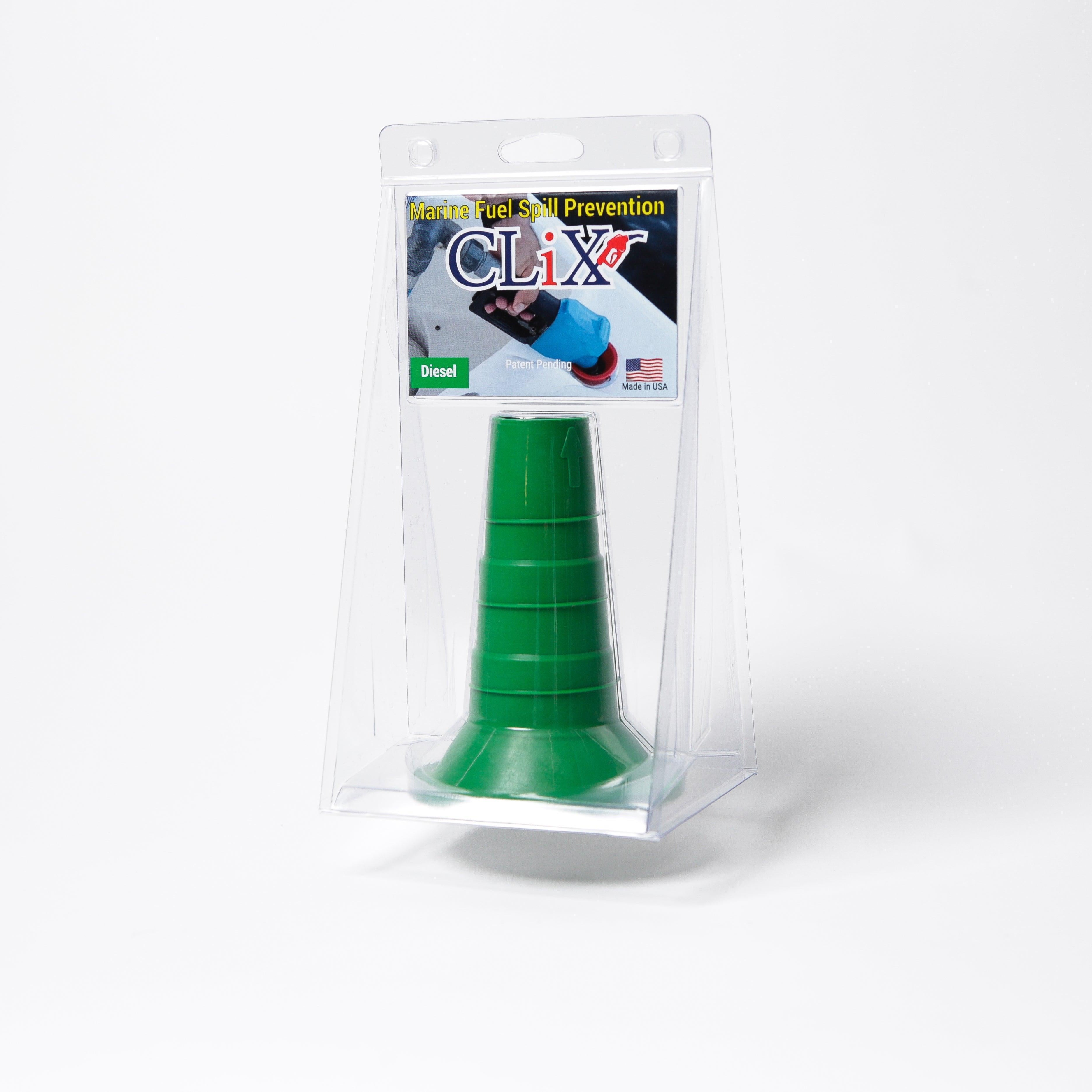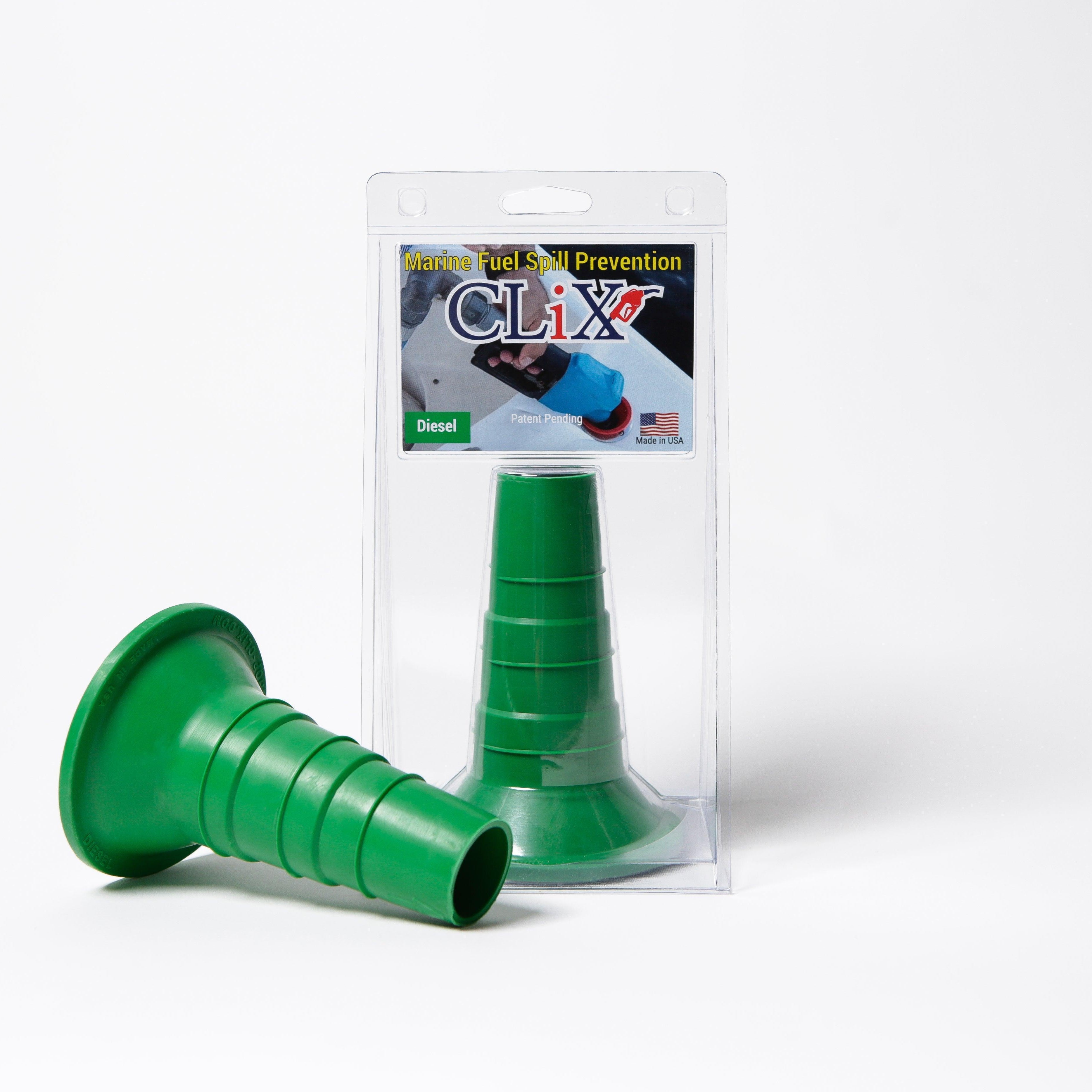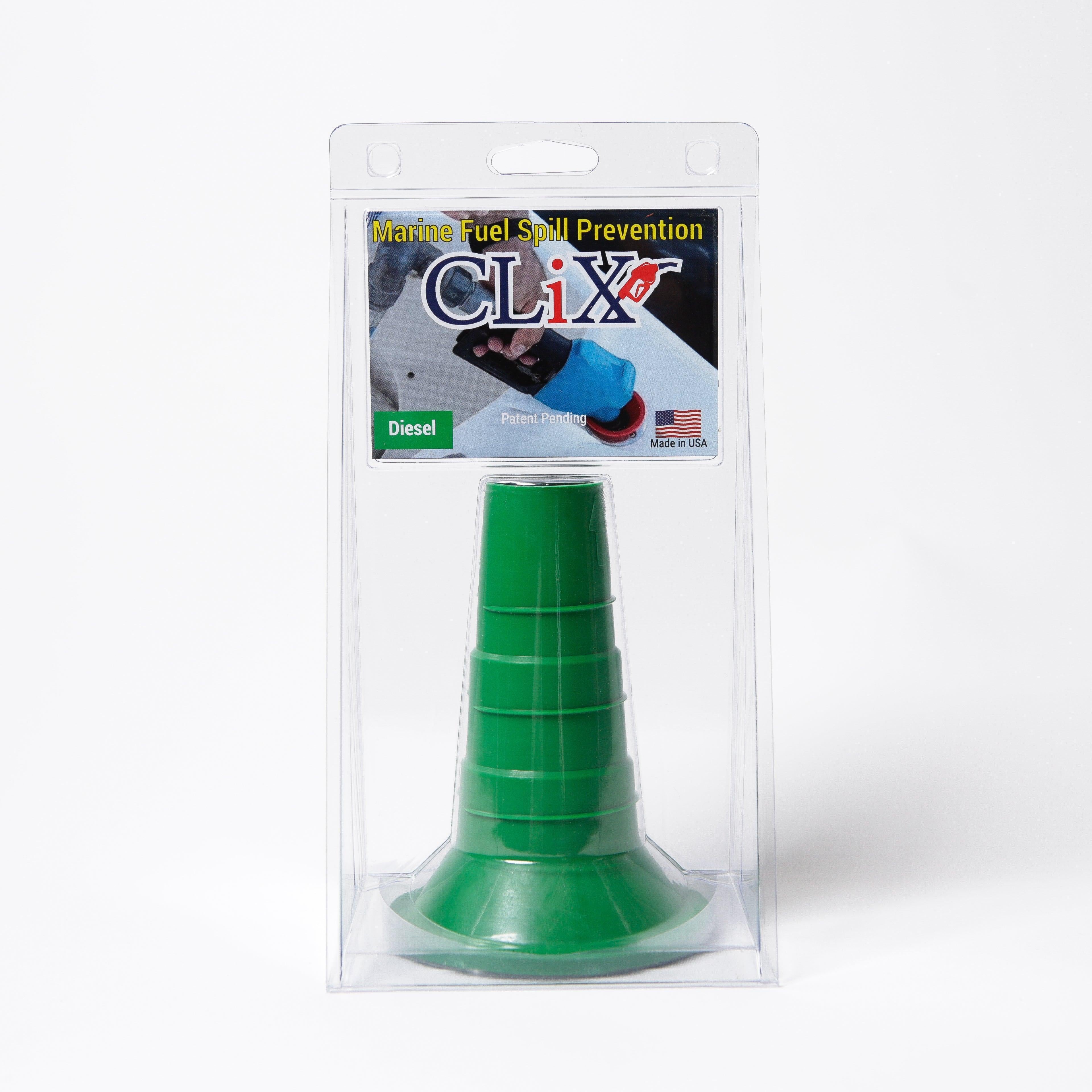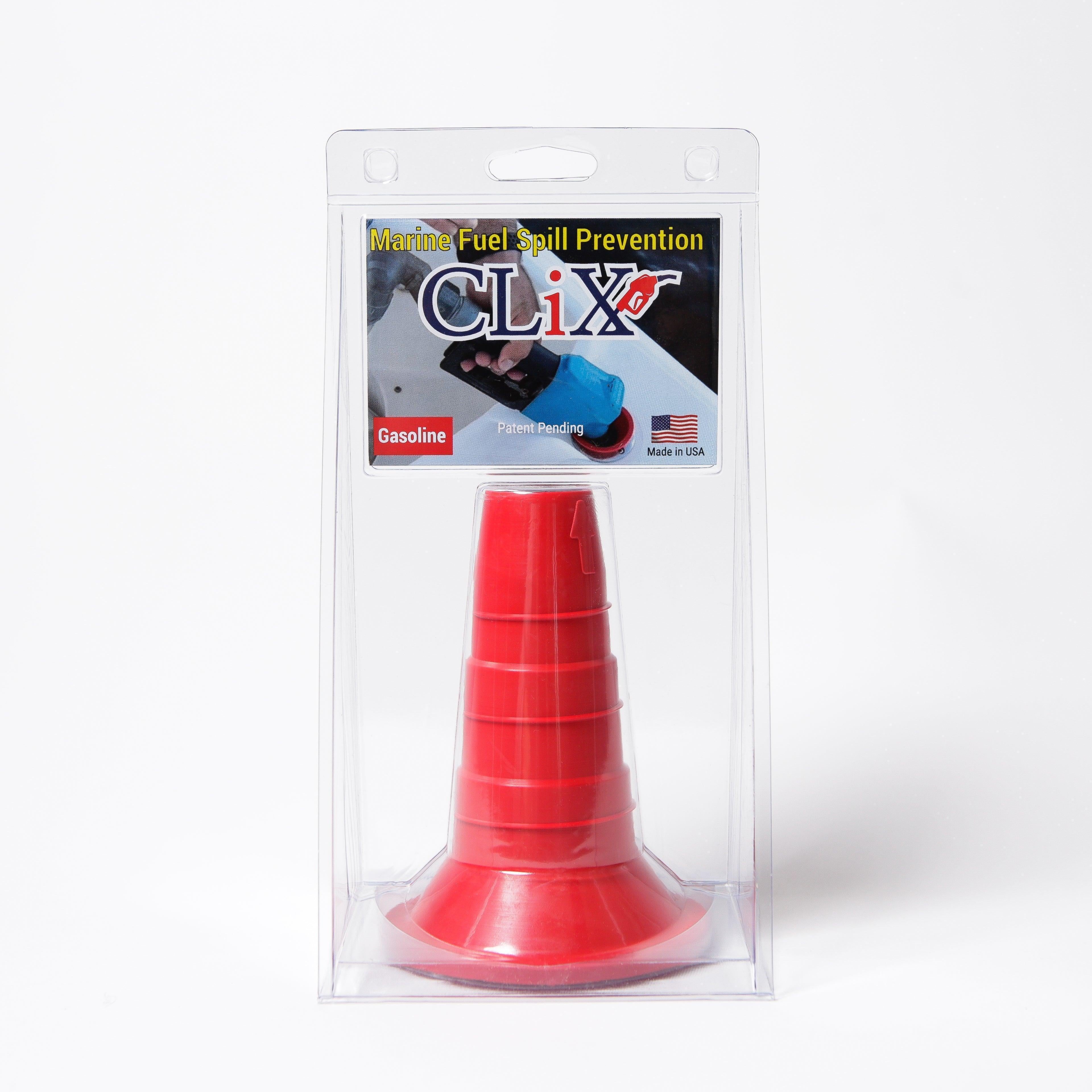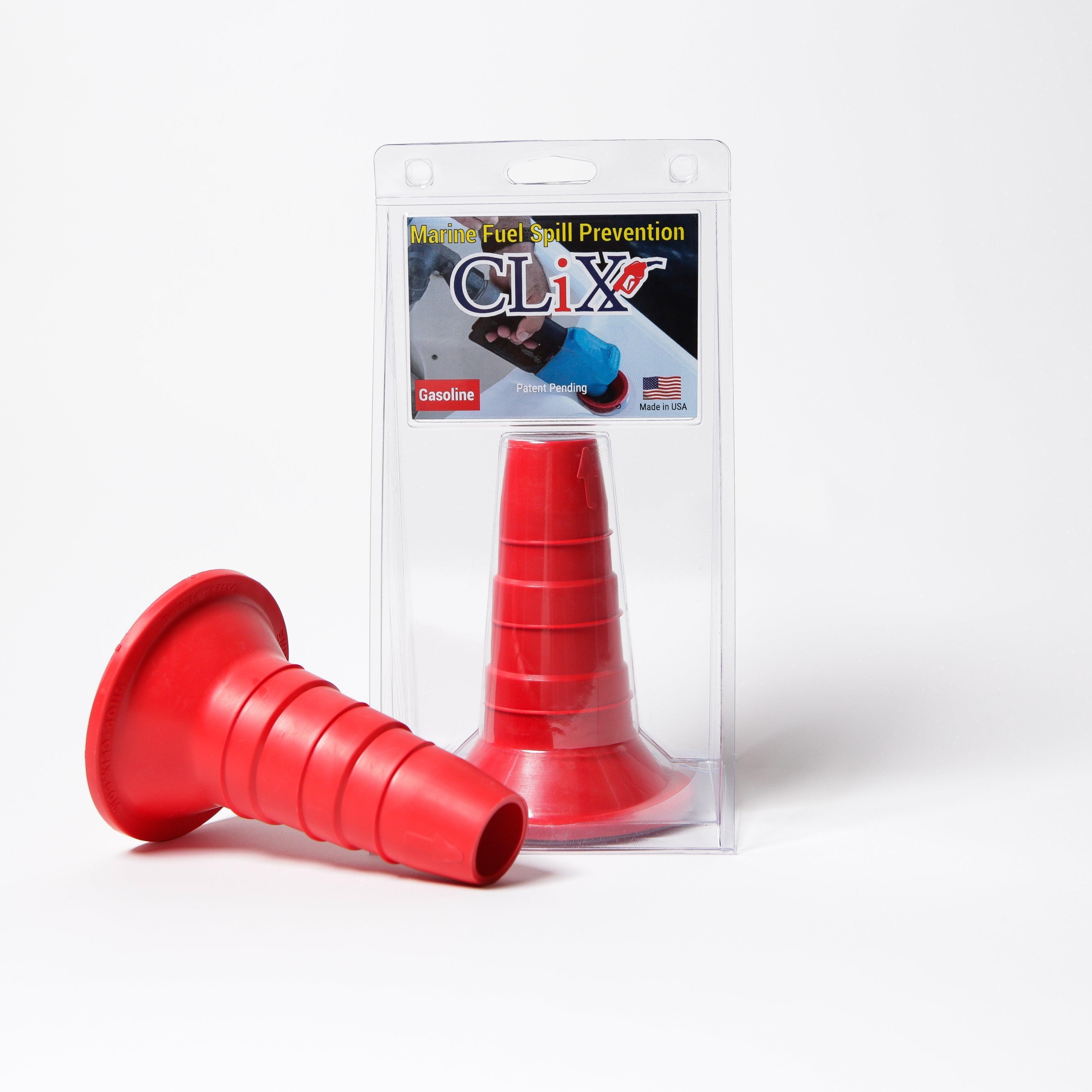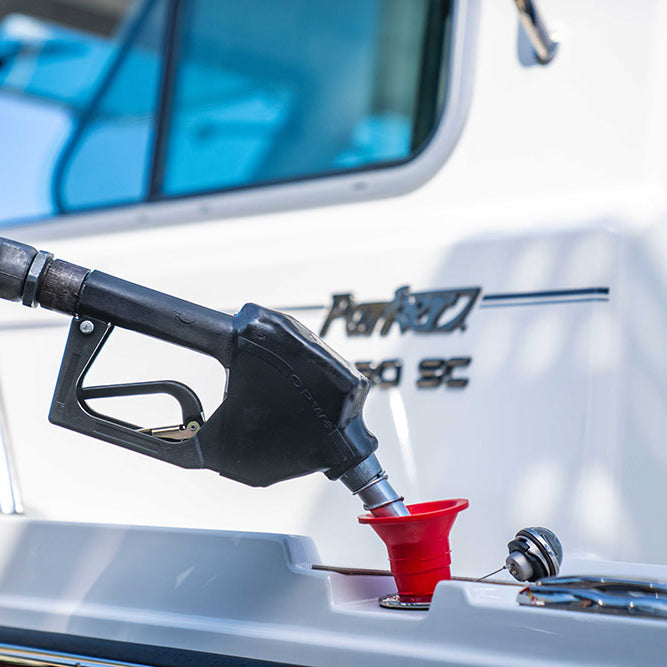A fuel filter funnel is a surprisingly simple tool that does a hugely important job: it cleans your fuel while you pour. Think of it as a first line of defense, catching nasty stuff like water, dirt, and rust before it ever gets into your boat's fuel tank.
It’s essentially a pre-filter, a simple guard standing watch over your engine's sensitive parts.
Why Your Boat Engine Needs a Fuel Filter Funnel
Every time you refuel, you're taking a bit of a gamble. It's easy to assume that the fuel coming out of the pump at the marina is perfectly clean, but that's often not the case. Even fuel that looks crystal clear can be hiding contaminants that can shut your engine down and leave you stranded.
A fuel filter funnel acts like a high-tech strainer for your fuel. As you pour, it physically stops solid particles—think rust, sand, and other grit—from getting through. But the real magic is how many of them handle water. They often use a special hydrophobic screen that lets fuel pass right through but stops water in its tracks, which is a massive headache for any boater.
The Hidden Dangers in Your Fuel
Picture this: you're miles from shore on a perfect day, and suddenly, your engine coughs, sputters, and dies. What happened? A tiny piece of gunk from your last fill-up just clogged a fuel line. It's a frustrating, and potentially dangerous, scenario that a simple funnel could have prevented.
The problems these funnels solve are incredibly common and can be very expensive to fix.
- Water Contamination: This is a big one. Water in your fuel leads to corrosion, poor performance, and even encourages microbial growth (the dreaded "fuel bugs").
- Solid Debris: Dirt and sand can easily clog sensitive fuel injectors, starving the engine of fuel and causing serious damage.
- Rust Particles: Whether they come from old storage tanks or jerry cans, rust flakes can destroy a fuel pump in no time.
It’s no surprise that people are paying more attention to keeping their fuel clean. The global market for automotive fuel filters was valued at around USD 2.77 billion and is expected to climb past USD 5 billion by 2034. That trend tells you just how vital good filtration is for modern engines. You can dig deeper into the numbers in this report on the automotive fuel filter market.
A Quick Look at the Benefits
At the end of the day, using a fuel filter funnel is a small, proactive step that delivers huge peace of mind. It doesn't replace your boat's main filtration system; it works right alongside it. It’s an extra layer of protection that complements your primary marine fuel filter to keep your engine safe.
Here’s a quick rundown of the problems a fuel filter funnel can solve before they ever start.
Problems Solved by Fuel Filter Funnels
This table offers a quick look at common fuel-related issues and how this simple tool provides an effective solution.
| Common Fuel Problem | How a Fuel Filter Funnel Helps |
|---|---|
| Water in Fuel | Separates and traps water in the sump, preventing it from ever entering the tank. |
| Dirt & Debris | The fine-mesh screen physically blocks solid particles from passing through. |
| Rust Flakes | Catches rust from jerry cans or storage tanks before it can clog your fuel lines. |
| Phase Separation | Helps you spot E10/ethanol fuel issues by trapping the separated water/ethanol mix. |
It's a straightforward fix for some of the most persistent problems boaters face with their fuel systems.
How These Funnels Magically Separate Water from Fuel
It seems a bit like magic, doesn't it? How can a simple-looking funnel possibly know the difference between fuel and water? The secret isn't sorcery; it's just some really clever science that starts with something most of us do every morning: making coffee. A coffee filter lets the good stuff—the coffee—pass through while stopping the solid grounds.
A fuel filter funnel works on a similar idea, but it’s a whole lot more advanced. It’s not just catching solids; its main job is to stop water, a boater’s worst enemy. And that’s where the real genius is.
The Hydrophobic Barrier Technology
At the heart of it all is a specially designed filter screen. It's usually a stainless steel mesh coated with a fluoropolymer, like Teflon. This coating creates what’s called a hydrophobic surface. It’s a fancy term, but all it means is that the material is engineered to repel water on a molecular level.
Picture a freshly waxed car in the rain. The water doesn't smear and soak in; it beads up into tiny droplets and rolls right off. The funnel's screen does the exact same thing to any water mixed in with your fuel.
- Fuel Passes Through: Gasoline and diesel molecules are much smaller and have different properties, so they slip right through the microscopic pores in the filter screen.
- Water Gets Rejected: The larger water molecules, however, are actively pushed away by that hydrophobic coating. They can't get through.
- Contaminants Are Trapped: At the same time, the fine mesh acts like a physical net, catching solid gunk like rust, dirt, and sand, just like that coffee filter we talked about.
As you pour, the water droplets and debris that get rejected are heavier than the fuel. Gravity takes over, pulling them down into a little collection area, or sump, at the bottom of the funnel. Once you're done fueling, you can just dump out the gunk that’s been collected.
This diagram helps visualize where the funnel fits into your boat’s fuel system, from the pump all the way to the engine.

You can see the funnel acting as a critical checkpoint, cleaning the fuel before it even gets into your tank. While the funnel is your first line of defense at the pump, it’s important to remember it works alongside your boat’s built-in system. To get the full picture, it's worth learning more about the role of a permanent fuel water separator filter.
By stopping contamination at the source, a fuel filter funnel drastically reduces the workload on your boat's primary filter, extending its life and preventing costly engine issues down the line.
At the end of the day, this simple but brilliant technology gives you an essential layer of protection. It makes sure that only clean, pure fuel gets into your tank, guarding your engine against the quiet but destructive damage that water and debris can cause.
Choosing the Right Fuel Filter Funnel for Your Boat
Picking the right fuel filter funnel isn't as simple as grabbing the first one you see on the shelf. It’s a lot like choosing the right fishing lure—what works in one spot might not be the best choice for another. To really protect your boat's engine, you need to match the funnel to your specific situation, from how big your boat is to the kind of fuel you're pumping.
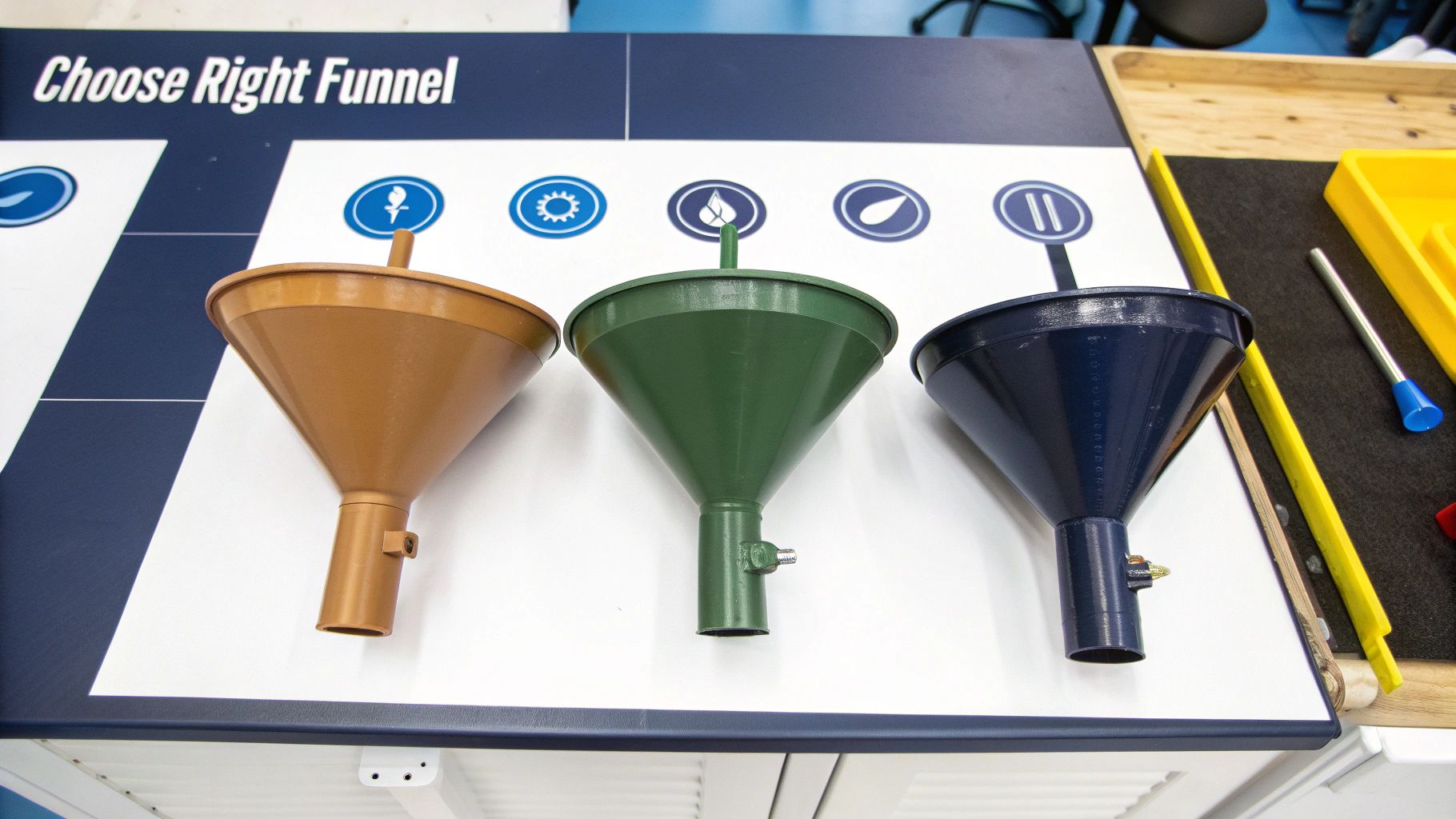
When you look at the specs, you’ll see a few key numbers and features that make a huge difference in performance. Getting these right means you’re not just buying a piece of plastic; you're investing in a critical piece of gear that makes fueling up faster, safer, and a whole lot cleaner for your engine.
Key Specifications to Consider
When you're comparing funnels, there are really three things that matter most: flow rate, micron rating, and the material it's made from. Each one plays a big role in how well the funnel does its job.
-
Flow Rate: This is measured in gallons per minute (GPM) and tells you exactly how fast fuel can pour through. If you've got a big boat with large tanks, a higher GPM is a lifesaver—it'll cut your time at the fuel dock. For smaller boats or portable cans, a lower flow rate is perfectly fine.
-
Micron Rating: This number tells you how small of a particle the filter can trap. A micron is tiny (one-millionth of a meter), so a lower number is better. For example, a funnel with a 74-micron rating will catch much finer gunk than one with a 150-micron rating.
-
Material and Safety: This is non-negotiable. Your funnel must be made from anti-static conductive materials. This feature is absolutely critical for preventing static electricity from building up as fuel flows through, which could create a spark and a very dangerous situation.
The Importance of Advanced Filtration
The filter screen inside the funnel is where the magic happens. The filtration technology is evolving all the time, and good funnels use fine-mesh screens that can trap even the smallest troublemakers. This isn't just about keeping chunks of dirt out of your tank.
Choosing a funnel with a proven, high-quality filter isn't just about catching dirt; it's about protecting sensitive engine components like fuel injectors from microscopic damage that can lead to costly repairs.
Let's break down how each of these features impacts your time on the water.
Feature Comparison for Fuel Filter Funnels
This chart compares key specifications to help boaters choose the right funnel based on their needs, such as boat size and fuel type.
| Feature | What to Consider | Impact on Performance |
|---|---|---|
| Flow Rate (GPM) | Your boat's fuel tank size and how quickly you want to refuel. | A high GPM means faster refueling for large tanks, while a low GPM is fine for smaller vessels. |
| Micron Rating | The level of filtration you need. Lower numbers mean finer filtration. | A lower micron rating offers better protection against smaller particles but may slow the flow rate slightly. |
| Material | Safety is key. Look for anti-static conductive plastic. | Conductive materials prevent static sparks, a major safety hazard when handling gasoline or diesel. |
| Fuel Compatibility | Whether you use gasoline, diesel, or other fuels. | Always confirm the funnel is rated for your specific fuel type to avoid material degradation or damage. |
Thinking through these factors before you buy will help you land on a fuel filter funnel that’s a perfect match for your boat. It’s a small step that gives you a lot of peace of mind every time you fuel up.
Best Practices for Using and Maintaining Your Funnel
Having a good fuel filter funnel is one thing, but knowing how to use it right is what really saves your engine. It's kind of like having a top-of-the-line fishing reel—it's only as good as the person using it. A few simple habits will ensure you get the protection you paid for every single time you top off the tank.
Your routine should start before you even twist open the gas cap. Give your funnel a quick once-over. Are there any cracks in the plastic? Is the filter screen torn or damaged? A tiny hole is all it takes for gunk to get through, which completely defeats the purpose of using the funnel in the first place.
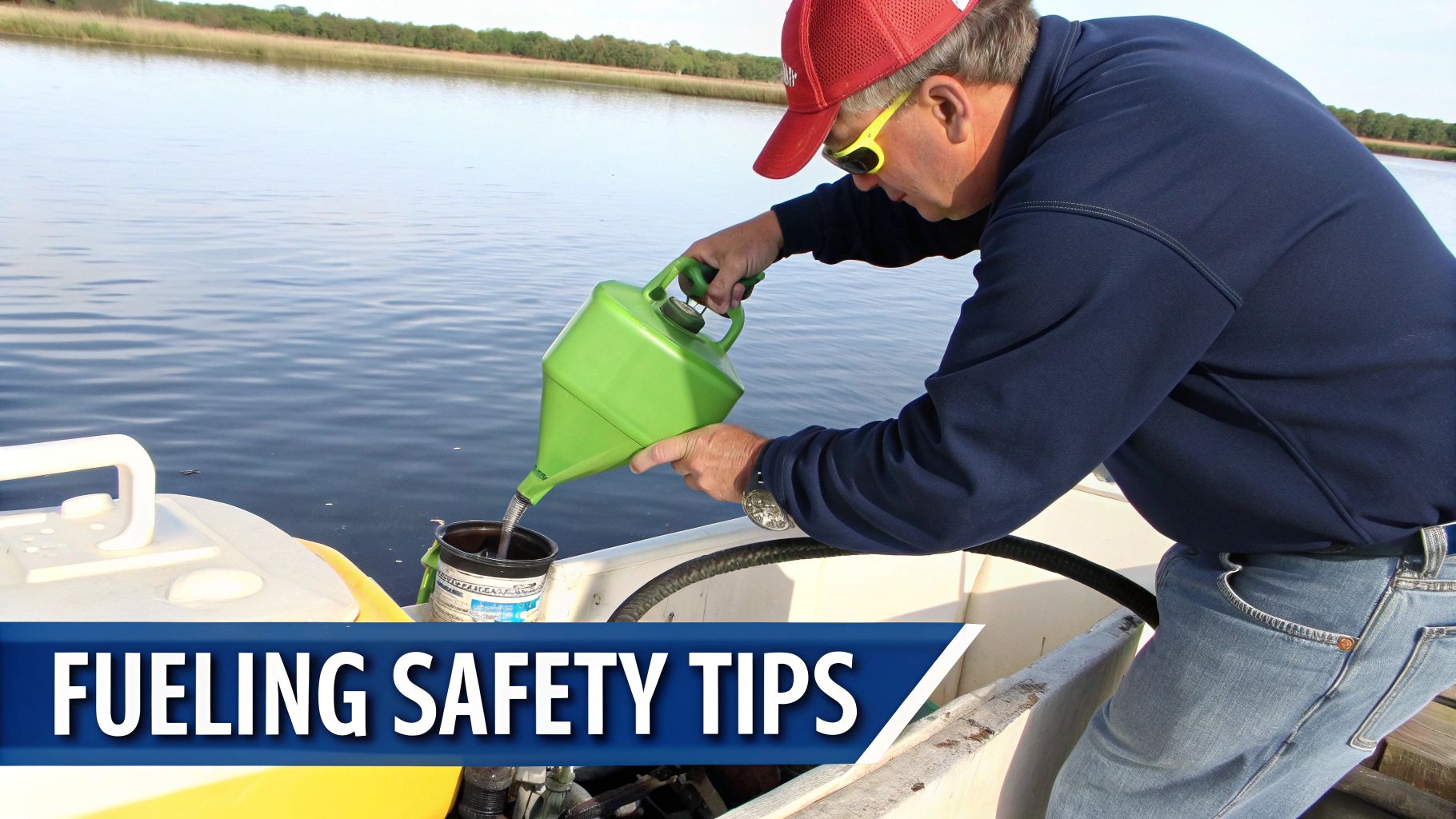
Proper Pouring and Inspection
When it's time to pour, make sure the funnel is seated firmly in your boat’s fuel fill. A wobbly funnel is an invitation for a spill, and it also leaves a gap for dust and dirt to blow right into your tank.
Start pouring the fuel at a nice, steady pace. If you go too fast and just dump it in, you can overwhelm the filter. This can force contaminants through the screen or, worse, cause fuel to slosh out onto your deck. A smooth, controlled pour gives the fuel filter funnels the time they need to properly separate water and catch all that nasty debris.
Once you’re done, don’t just put the funnel away. Take a peek into the sump area at the bottom. What you see tells a story. A lot of water or a nasty collection of rust particles is a huge red flag about the quality of fuel you're getting from your source.
Checking the gunk in your funnel's sump after every fill-up is the best and cheapest way to keep an eye on the fuel you're putting in your boat.
Cleaning and Maintenance Tips
Keeping your funnel clean is non-negotiable if you want it to work long-term. The single biggest mistake you can make is washing it with soap and water. Soaps and detergents will strip the special hydrophobic coating right off the filter, completely destroying its ability to repel water.
Instead, just follow these four easy steps:
- Empty the Sump: Carefully dump the trapped water and debris into a proper waste container. Never, ever just toss it overboard.
- Rinse with Clean Fuel: Swirl a little bit of clean fuel—gasoline or diesel, whatever you use—around the inside to wash away any leftover particles.
- Air Dry Thoroughly: The best way to dry it is the simplest. Just turn it upside down and let it air dry. Wiping it with an old shop rag will just put dirt right back into it.
- Store Properly: Tuck your clean, dry funnel away in a dedicated spot, like a clean locker or even a plastic bag. This keeps it from getting dusty and dirty before its next use.
By making these simple steps part of your fueling routine, your funnel will keep protecting your engine trip after trip, season after season.
Beyond the Funnel: A Smarter Fueling System
A good fuel filter funnel is a non-negotiable tool for any boater. It's your first line of defense, a simple but brilliant guard that keeps water and junk out of your fuel tank. And for that, it’s fantastic.
But what about the other headaches at the fuel dock? A funnel can’t stop that gut-wrenching moment when fuel burps out of the fill, spilling across your deck and into the water. That’s a whole different problem.
This is where you have to think beyond just purity and consider fuel containment. Spills are messy, they waste money, and they’re terrible for the very waters we love to be on.
The Other Half of the Equation
Think of your fuel filter funnel as the world's best bouncer. It stands at the door, meticulously checking every drop of fuel and tossing out any water or debris that tries to sneak in. It does its job perfectly.
The problem is, the bouncer has no idea when the club is full. That's why overfills are still a constant risk.
This is where a system like CLiX Fueling Solutions comes in. It’s the perfect partner to your funnel, adding a layer of safety and control that a funnel simply wasn't designed to provide.
A fuel filter funnel protects your engine from the inside by keeping the fuel clean. A smart fueling device protects your boat and the environment from the outside by preventing spills. They’re two different tools for two different jobs.
How It All Works Together
Imagine this: you’re at the dock, your funnel is cleaning the fuel on its way in, and another device is standing by to intelligently shut off the pump the instant your tank is full. This isn't some far-off idea; it's exactly how these two pieces of gear work together.
- Clean Fuel In: You use your fuel filter funnels just like you always do, letting that hydrophobic screen do its magic on water and contaminants.
- Spill-Proof Connection: The CLiX device clicks on, creating a sealed link between the fuel nozzle and your boat’s deck fill.
- Automatic Shut-Off: The moment your tank is full, CLiX technology triggers the fuel pump nozzle to click off—just like it does when you fill up your car. No more listening for the gurgle, no more messy guesswork, and zero overflow.
That sealed connection has another benefit, too. It stops salt spray, dust, and airborne moisture from getting blown into your tank while you’re fueling up—a subtle but very real source of contamination most people overlook.
By combining the filtration power of a quality funnel with the spill-proof, automatic shut-off from CLiX, you’ve built a complete defense. It’s the difference between just locking your front door and having a full security system. To see the bigger picture, you can check out this complete guide to a modern boat fuel management system. This two-part approach is what finally gives boaters total peace of mind at the pump.
Answering Your Top Questions About Fuel Filter Funnels
Even after you get the hang of using a fuel filter funnel, a few questions are bound to pop up. That’s totally normal. Nailing the little details is what gives you the confidence that you’re doing right by your engine every time you fill up.
We've pulled together the most common questions we hear from other boaters. Think of this as your go-to cheat sheet for mastering your fueling routine.
Can I Use the Same Funnel for Gas and Diesel?
The short answer is yes. Most quality funnels are built from materials that can handle gasoline, diesel, and even kerosene without breaking down.
But—and this is a big but—it’s always smart to check the manufacturer’s notes just to be sure. Honestly, the best practice is to have separate, clearly marked funnels for each fuel type. It’s a simple step that completely removes any chance of cross-contamination, which can cause a world of hurt for your engine. A little caution here goes a long way.
How Do I Know When It's Time to Replace My Funnel?
A well-cared-for funnel can last for years, but it won't last forever. It’s time for a new one if you see any obvious damage, like cracks in the plastic or a tear in that fine filter screen. Even a pinhole-sized rip makes the whole thing useless.
The other big clue is a sudden drop in flow rate. If you've cleaned it and fuel is still trickling through at a snail's pace, that's a bad sign.
When the flow rate slows to a crawl and cleaning doesn't help, it usually means the filter is permanently clogged with tiny particles you can't even see. It’s done its job, but it’s time for retirement.
Just give it a quick once-over before you use it each time. It’s a good habit to get into.
Does a Funnel Mean I Don't Need My Boat's Fuel Filter?
No, absolutely not. This is a critical point to remember. The funnel is your first line of defense. It’s a pre-filter that stops gunk from ever reaching your fuel tank in the first place.
Your boat's onboard fuel filter and water separator is the final gatekeeper, protecting the most sensitive parts of your engine. Using a funnel will make your onboard filters last much, much longer and save you some hassle, but it’s an extra layer of protection, not a replacement.
What's the Deal with the Micron Rating?
The micron rating simply tells you how fine the filter is. A micron is one-millionth of a meter—in other words, tiny. The rating is a direct measure of the smallest particle the filter can reliably catch.
- A 100-micron rating will stop contaminants that are 100 microns and larger.
- A smaller number, like 50 microns, means it’s a finer mesh that can trap even smaller bits of debris.
While a finer filter might seem better, it can also slow down the fueling process. For most of us on the water, a funnel with a rating between 50 and 150 microns hits that sweet spot between great protection and a decent flow rate.
While a funnel keeps your fuel clean, CLiX Fueling Solutions keeps your fueling clean. Put them together, and you have a bulletproof system that protects your engine, your boat, and the water. Learn how to make fuel spills a thing of the past.

